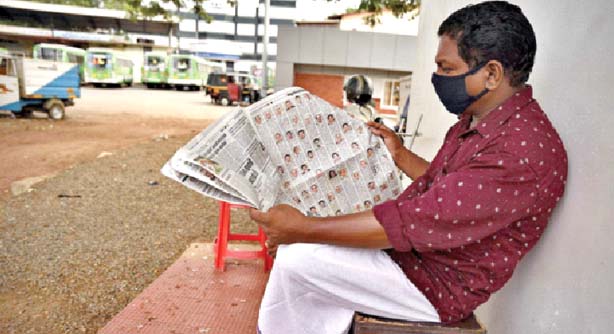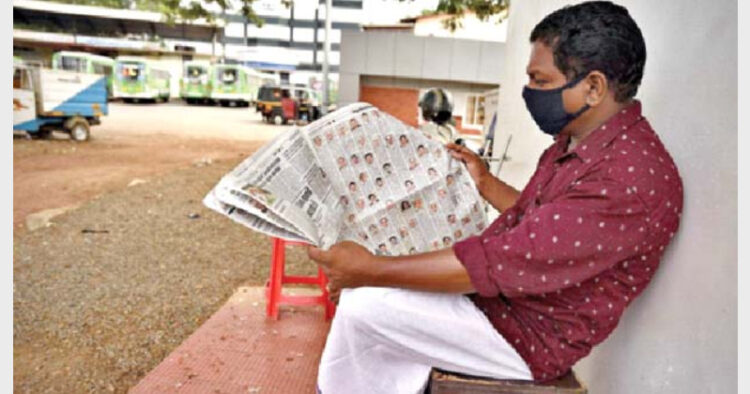This is the billion rupee question facing the print media industry today. If one were to hazard a guess, a certain percentage of readers would have permanently moved away from this morning addiction. They would have settled down to tracking a couple of news portals on their cell phones and may not return to the printed versions ever
-A Surya Prakash

A man wearing a mask reading a newspaper at a bus terminus which has been shut down for more than a month as part of measures to curb the spread of the COVID-19 pandemic in Kochi, Kerala
The adverse impact of COVID pandemic has been substantial in almost every sector of the economy and the print media has been no exception. Soon after the Union Government announced the first lockdown in the early hours of March 25, newspaper vendors had to bear the brunt. The police wielded their lathis to drive away all the vendors, saying this was not an ‘essential’ service. The Union Government soon stepped in and said the lockdown should not affect the distribution of newspapers every morning. But, the woes of the print media did not end here. Because the global panic created by the pandemic and the unfounded fears and rumours about possible transmission of the virus resulted in Resident Welfare Associations (RWAs) in all the metros and towns barring the entry of newspaper vendors.
The newspaper industry had to collectively mount a campaign to explain that newspapers, after all, are not virus carriers. They also had to get the RWAs to revoke their directions and to allow the vendors in. But, all this has not restored normalcy vis-à-vis distribution and circulation, because a good percentage of consumers do not want to pick up a newspaper in the morning. Meanwhile, newspapers are witnessing a slump in advertising because of the hurdles in distribution and circulation. The number of pages has been slashed. The daily newspaper, which in the pre-COVID era was 28 or 32 pages, is now an emaciated 12 pages.
While the print media has hit a bad patch, other arms of the media – television and social media platforms – are seeing a boom. Years ago, television news channels had just five per cent of the overall television advertising pie, with General Entertainment Channels (GECs) gobbling up most of it. In more recent years, with rising political temperature, the advertising share of news channels had risen to 8 per cent. This may see a bump in these COVID months, but a slump may follow because of the disastrous impact that Corona Virus is having on the Indian and global economy.
Similarly, online editions of newspapers see a huge increase in viewership and this is likely to sustain after the world has successfully tackled the current health crisis. However, the online business too will have to brace itself for a fall in revenue.
So, where do we go from here? One day the lockdown will end and the vendors will be back to delivering the morning papers at everyone’s doorstep. But, having voluntarily or otherwise stayed away from the morning addiction for two months or more, will newspaper readers ever return to the habit once the lockdown is lifted?
This is the million-dollar question facing the industry today. If one were to hazard a guess, a certain percentage of readers will have permanently moved away from this morning addiction. They would have settled down to tracking a couple of news portals on their cell phones and may not return to the print version ever.
This reminds me of my experience in North America a long time ago. One of the first things I noticed in 2008 when I went to visit my son, who was studying in Toronto, was that there was no newspaper at his doorstep in the morning. Nor did he have a television set. He would give me the links to Indian newspapers on his iPad and Indian news television stations on his Desktop.
I also noticed that there was hardly anyone in his apartment block subscribing to a printed version of a newspaper. The scene was almost similar when I visited friends and family in the United States (US) as well. I then realised that it would be almost impossible to get a photograph of an individual below the age of 30 in the US or Canada holding a daily newspaper in his or her hand and reading it. The younger generation felt that it was out of fashion. Online subscriptions made sense.
That was also the time when media professionals in both these countries told me that the print version of newspapers was dying out and there were major job losses in the newspaper industry. When I told them that on the other hand there was a media boom in India and newspaper circulation graph was heading northward, they were wondering if this would open up job opportunities for them!
India’s media boom was triggered by economic prosperity that came with the opening up of the economy by Prime Minister Narasimha Rao in 1999, coupled with a substantial jump in literacy levels. India’s literacy levels which hovered below 50 per cent in large parts of the country has now touched a national average of 75 per cent, and this has played an important role in the steady growth of the print media.
Also, economic prosperity has pushed up media consumption. India has about 250 million households. According to the annual reports of the Registrar of Newspapers (RNI), the circulation of daily newspapers was just 22.60 million in 1990; 78.70 million in 2008; and 275.36 million in 2017. Similarly, the number of Cable & Satellite (C&S) homes in India, which was just one million in 1990, touched 180 million in 2018.
Newspapers must be ready to face a slump in revenue and circulation for some years until the economy picks up again and the millions outside the print media net due to economic reasons find the wherewithal to buy newspapers. In the meanwhile, it is worthwhile looking at another graph – that of the youth or say those between 15-30 age group, who will permanently move away from the printed newspaper and shift to digital options
This upward swing ought to continue in our country because around 300 million people are still below the poverty line and lacking the economic power to venture into media consumption. This was expected to increase in the decade ahead, but the COVID economic setback may retard this process, adversely impacting newspaper circulation and viability of television news as well.
According to CISCO, India will have 829 million internet users by 2021. Also, out of 1100 million mobile phones in operation in India, over 450 million are smartphones with the ability to easily navigate to various sites, download Apps and store data. This will see a big boom in online news services of established print entities and other players. Further, the popularity of FM Radio will go up because they can be accessed through smartphones and the youth relate to this chatty, modern medium.
What does all this mean for the media industry in India? Or, as they say in Hindi, what is the Taatparya?
Well, newspapers must brace for a slump in revenue and circulation for some years until the economy picks up again and the millions outside the print media net due to economic reasons find the wherewithal to buy newspapers. In the meanwhile, it is worthwhile looking at another graph – that of the youth or say those between 15-30 age group, who will permanently move away from the printed newspaper and shift to digital options. This graph will move southward. The two graphs will cross each others path about a decade from now, after which the momentum will wholly be towards digital media.
In other words, at some point in the future, Indian newspapers and magazines will begin shutting down their print editions like their American and British counterparts and turn the focus entirely onto the digital versions of their publications. The business model will change, the “newspaper boys” will become unemployed, will re-skill themselves and return to the industry in a new role. Similar, dramatic changes which have begun in the television news industry will get accelerated. Camera phones will replace five to eight kg cameras and the ‘lean and mean’ mantra will be back with a vengeance. Further, vertical integration of media enterprises will hasten and most media companies will be three-in-one media houses offering print, online news and news on video. Meanwhile, all media entities will have to cope with another monster at the door – the citizen journalist, who is using Twitter, Facebook, Instagram and become his own publisher and challenging the monopoly of media houses to what is known as breaking news!
Those who understand technology, the declining attention span of the modern man and grasp the aspirations and needs of GenNext will survive. The others will perish. But, one thing is certain – news, and that too, real breaking news, will never go out of fashion!
(The writer is a senior journalist and former chairperson of Prasar Bharati)














Comments